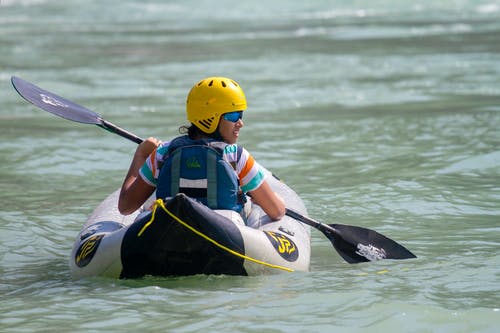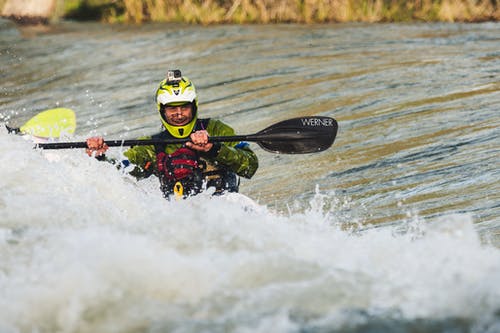Whether you want to use the sit-on-top or sit-inside kayak, the most important thing to consider is your safety.
Which is safer sit-inside or sit-on-top kayak? The two kayaks are safe, but stability depends on factors such as size and hull design.

Here is what you should know about the two kayaks:
Table of Contents
Sit-Inside Kayak
When it comes to the sit-inside kayak, the center of gravity is lower than that of a sit-on-top kayak.
This provides you with better secondary stability. With this sitting arrangement, you can lean the boat on its side edge to turn better and stay upright in rough waters.
Since the sit-inside kayaks have a lower center of gravity, the models come much narrower than a sit-on-top model.
The slimmer and longer construction makes the model be faster. It is also easier to paddle, which makes them suitable for your long adventures.
The lower profile ensures that it is not affected by wind greatly. The enclosed cockpit offers you protection from the sun or rough water.
You can use a spray skirt to attach to the cockpit for full protection from rain, snow, or frigid water during winter paddling.
In addition, a well-sealed high-quality spray skirt can keep water out of the cockpit when the kayak capsizes or in case you flip.
When you sit inside a cockpit, you can place your legs against the side of the kayak and the underside of the deck.
This helps you to control the kayak, and makes it more maneuverable. There would be enough space for you to store your gear and keep them dry.
You should know that water does not get in through self-draining scupper holes. Some sit-in kayaks come with integrated watertight storage compartments.
You can use a short paddle because of its narrower beam. This makes the boat easier to propel forward.
The reason is that the moment arm will be tighter.
Sit-On-Top Kayak
The sit-on-to kayak comes with a wider beam to help it with its initial stability. With the wider beam, you can easily use it than sit-in kayaks.
The model is easy for paddlers to get in and out of. This means you can safely jump into the water and climb back.
In a cause where the kayak flips over, you would not experience swamping or filling up since it lacks a cockpit.
Paddlers can flip it back over faster and climb back on. Water left on its deck drains away fast through self-bailing drain holes.
The sit-on-top kayak’s design is convenient when landing and launching. You can lower yourself onto the seat and swing your legs on if you launch from knee-deep water.
People with mobility problem prefer this model. It has no cockpit to fit into and suitable for larger people.
The kayak has more storage space and great for people on multi-day camping trips. Everything is on the deck, and access to the gear is more comfortable.
This means that you do not have to struggle and reach deep into your cockpit to get your things.
This is important for fishermen, who need space to store their gear and freedom of movement to use their equipment. All fishing kayaks are of the sit-on-top variety.
Sit-on-top kayaks are cheaper as well.
Recreational kayaks:
These can either be sit-inside kayaks or sit-on-top kayaks. They are very affordable, and stable. In addition, entry and exit out of this kayak are very easy and convenient. They are also simple to turn.
While recreational kayaks may not be used for longer trips, rapids, or waves, they are used for flatwater fun or meandering rivers,
Touring kayaks:
These are sit-inside sea kayaks, which are long, robust touring boats that are highly efficient over distances.
On touring kayaks, rapids that are up to class III are quite manageable for paddlers using the longer, stable boat or one that is short enough to turn on a dime.
However, some kayaks can handle up to class II and even class III rapids but they require paddlers with professional paddling skills.
Specialized sport kayak and training are also recommended for rapids
Which is safer sit in or sit on kayak?
The sit-inside and the sit-on-top kayak are very safe and can provide paddlers with a great kayaking experience.
Although their designs are different, they are both comfortable and safe for use.
However, the level of stability that these kayaks provide depends largely on their design and size.

Which is more stable a sit-in or a kayak?
For stability, a sit-inside or an open-cockpit kayak is much more stable than a sit-on-top kayak. Unlike the sit-on-top kayak, in the open-cockpit kayak, the paddler sits lower in the kayak and the rear end is near or at the level of water.
In sit-on-top kayaks, it is easier to lose your balance and anything can cause the paddler to lose balance because the center of gravity is higher.
Why is stability important for a kayak?
The stability of a kayak is very important for paddlers.
It is a crucial factor to consider before deciding to use a particular type of kayak as it determines to a large extent, the convenience and efficiency of paddling.
With a stable kayak, paddlers can actually focus on paddling without being worried about tipping off or flipping over while on water.
As kayaks vary, the effects of an open cockpit kayak capsizing are quite different from that of a sit-on-top kayak capsizing.
Assuming a sit-on-top kayak capsizes, it can easily be turned right back up as long as all the hatches are closed and sealed.
Although climbing back may be a problem for some individuals, your kayak will not fill up with a large amount of water and you can continue kayaking.
If an open cockpit kayak capsizes, it may be a whole lot difficult to get it back up. More so, an open cockpit kayak will be filled with a significant amount of water.
Open cockpit kayaks made using good quality materials may not completely sink but in order to turn it back up, the paddler will definitely have to swim the kayak to shore except the paddler has a partner.
While a lot of people believe that inland bays are quite shallow and cab they can touch the bottom anywhere.
It will surprise you to know that five feet of the water is deep enough and will not permit the paddler to empty the kayak and still get back in it even if the paddler is eight feet tall.